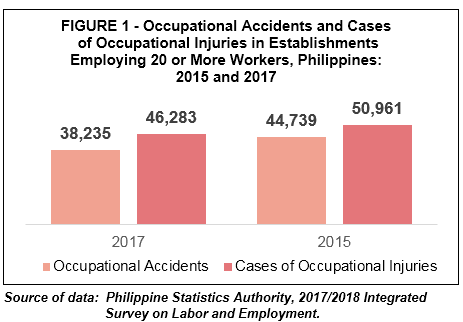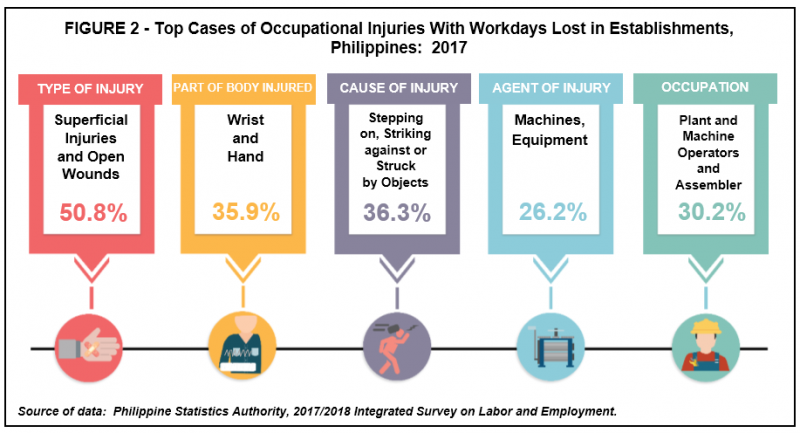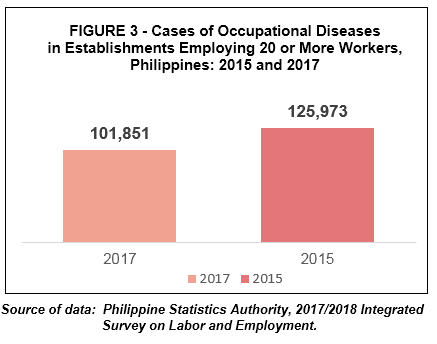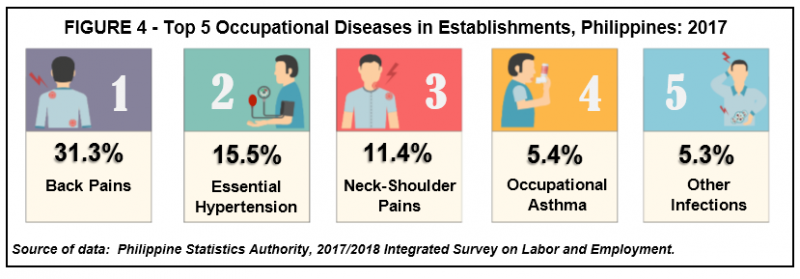Release Date :
Reference Number :
2019-214
- A total of 38,235 occupational accidents occurred in 2017. These work-related accidents were reported by about 16.3 percent of the total 32,288 establishments employing 20 or more workers in 2017.
- As a result of workplace accidents, about 46,283 cases of occupational injuries were recorded in 2017. Both cases of occupational accidents and cases of occupational injuries in 2017 were comparatively lower by 14.5 percent and 9.2 percent, respectively from 2015. (Figure 1)
- Among cases of occupational injuries, about 43.9 percent were non-fatal cases with lost workdays while about 1 percent were fatal cases. More than half of all occupational injuries (55.1%) were accounted to cases of injuries without lost workdays.
- By industry, manufacturing accounted for the highest share of occupational injuries at 49.7 percent of the total cases. Far second was wholesale and retail trade; repair of motorcycles at 11.4 percent, followed by administrative and support service activities at 7.2 percent share.

MEASURES OF SAFETY PERFOMANCE OF OCCUPATIONAL INJURIES
- The frequency rate in 2017 was registered at 1.75 percent. Approximately, there were 2 cases of occupational injuries with workdays lost reported per 1,000,000 employee-hours of exposure.
- The incidence rate in 2017 was posted at 4.27 percent which indicates that there were around 4 cases of occupational injuries with workdays lost per 1,000 workers.
- The severity rate was recorded at 9.68. This means that about 10 workdays were lost in cases of occupational injuries resulting to temporary incapacity per 1,000,000 employee-hours of exposure.
CASES OF OCCUPATIONAL INJURIES WITH WORKDAYS LOST BY CLASSIFICATION

TYPE OF INJURY
- Superficial injuries and open wounds were the most common type of occupational injuries with more than half or 50.8 percent of the total cases reported. This was followed by dislocations, sprains and strains with 12.0 percent and fractures with 10.7 percent.
PART OF BODY INJURED
- Wrist and hand was collectively recorded as the most injured part of body accounting for 35.9 percent. Lower extremities and arm and shoulder came next with 18.7 percent and 17.6 percent, respectively.
CAUSE OF INJURY
- The leading cause of work-related injury in establishments was stepping on, striking against or struck by objects, excluding falling objects (36.3%). Other causes of injury include caught in or between objects (21.0%) and falls of persons (10.5%).
AGENT OF INJURY
- The top three (3) agents of injuries in 2017 were machines and equipment (26.2%); materials and objects (24.4%); and hand tools (18.3%).
MAJOR OCCUPATION GROUP
- By major occupation group, 30.2 percent of the total 20,797 cases of occupational injuries with workdays lost in 2017 affected plant and machine operators and assemblers. Injuries to service and sales workers; and elementary occupations followed at 19.3 percent and 18.7 percent, respectively.
OCCUPATIONAL DISEASES
- Occurrences of occupational diseases in establishments employing 20 or more workers accounted to 101,851 cases in 2017. This was a decrease of 19.1 percent from 125,973 reported cases in 2015. (Figure 3)

- Topmost work-related diseases suffered by workers was back pains with 31.3 percent. Other most prevalent occupational diseases experienced were essential hypertension (15.5%) and neck-shoulder pains (11.4%).

- Workers engaged in administrative and support service activities reported the highest share of cases with occupational diseases with 31.8 percent. Followed by manufacturing industry (28.9%) and wholesale and retail trade; repair of motorcycles (9.6%).
CLAIRE DENNIS S. MAPA, Ph.D.
Undersecretary
National Statistician and Civil Registrar General
See more at the Integrated Survey on Labor and Employment Landing Page
